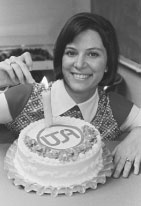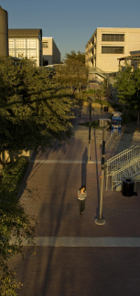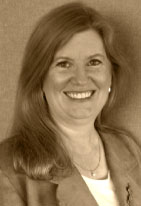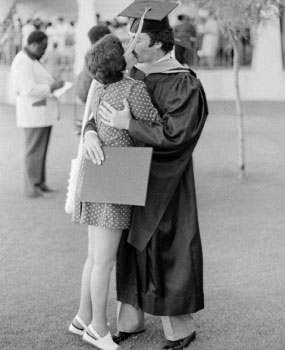Features
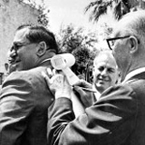
Look Who's 40
Forty and fabulous! The University of Texas at San Antonio celebrates 40 years of existence in 2009. To mark the occasion, Sombrilla takes an interactive multimedia stroll down memory lane.
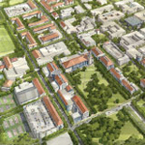
The Big Picture
Sombrilla takes a peek into the future and the new campus master plan. What does the future hold? A bell tower, lots of green space, and an extra 7.5 million square feet of building space for teaching, research, housing and recreation.

Tagging Talent
Senior Davin Gutierrez took his entrepreneurship class in a social direction when he established GRAFFITI Foundation, an enterprise meant to promote local artists and social awareness.
Investigations
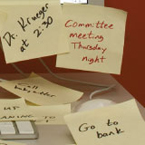
Making Memory Stick
Professor Rebekah Smith, who directs the UTSA Cognitive Aging Lab, was awarded a $1 million grant to study adult memory.
Plastic surgery for plants?
UTSA has received a grant to improve soil reinforcement by injecting living plant roots with plastic polymers to develop synthetic root systems.
Fighting valley fever
UTSA researchers have significantly advanced the fight against San Joaquin Valley Fever.
UTSA, SwRI partner in national research group
UTSA and SwRI have joined the Government-University-Industry Research Roundtable elite sub-unit of the National Academies, the nation's advisers in science, engineering and medicine.
Roadrunner Sports
Sports Briefs
UTSA to host 2011 NCAA Men's Basketball Southwest Regional; twelve student-athletes named All-Southland Conference; UTSA selects architect for Phase 1 of the UTSA Park West athletics complex.
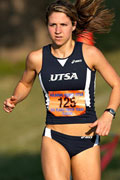
Engineered to Run
Dana Mecke has won more than her share of victories on sports fields, but she's just as impressive in the classroom.
In the Loop

Campus wedding celebration for diehard Roadrunners
Ashley Starkweather '09 and Tim Mazzanti '05, who met and fell in love on campus, were the first to hold a wedding reception in the University Center ballroom.
To Africa with books
UTSA's College of Education and Human Development has been selected to provide educational materials and teacher training to improve literacy rates of children in Africa.
Making dreams for San Antonio kids
UTSA Dream Runners help expose disadvantaged students to aspects of college life, both academic and social.
Integrating computer simulation research
UTSA researchers won a $5 million grant from the National Science Foundation to establish the Simulation, Visualization and Real-time Prediction (SiViRT) Center.
Biblioteca Beautification
A $3.1 million renovation of the John Peace Library on the Main Campus is bringing one of the university's oldest buildings straight into the 21st century.
Twice the gift
Valero Energy officials announced in September a $2.5 million gift to support graduate students in engineering and business.
Meeting of the Minds
Chemistry Ph.D. student Magaly Salinas made Roadrunner history as the first UTSA student to attend the 59th Meeting of Nobel Laureates and Students.
Telling the story of Texas
Timothy J. Gette is the new executive director of the Institute of Texan Cultures.
College of Architecture names new dean
John D. Murphy Jr. was named dean of the College of Architecture in May.
President's Dinner
UTSA celebrated its 40th anniversary and honored Texas House Speaker Joe Straus at this year's scholarship dinner.
Class Notes
Melanie Lane '09
Melanie Lane has two words for people struggling with issues of substance abuse: "Treatment works." Lane is the unit coordinator at the Restoration Center, a program of the Center for Health Care Services that is located on the new Haven for Hope campus in downtown San Antonio.
Lane Welter '85
For the record, Lane Welter's favorite sport will always be football. But Welter has made a career for himself because of another sport-baseball-after working as lead architect on several high-profile projects: Coors Field in Denver, Minute Maid Park in Houston and the renovation of RFK Stadium in Washington, D.C.
Joe Kustelski '78
When Joe Kustelski earned his bachelor's degree in biology from UTSA, he planned to stay right where he was, go to graduate school and eventually enter academia. But a rainstorm changed all that. Now, more than 30 years later, Kustelski is the field sales director for the Northeast Area Women's Health Care Division of Bayer HealthCare Pharmaceuticals.
Class Notes
Editor's Note
UTSA’s first student teaches me how to count
Peggy Jo Tholen has been an elementary school teacher for close to 30 years; the woman has simple addition and subtraction down pat. So, while she was gracious and willing to talk to me when I called to get her recollections of the university’s beginnings as part of our 40th anniversary coverage, she was pretty sure I had my years wrong.
"According to me, though, it’s not 40 years yet," she said. "Isn’t that a couple of years away?"
Because while folks here on campus are counting from when the Texas Legislature established the university in 1969, Tholen counts from 1973, the year UTSA offered its first classes. In fact, on June 5, 1974, Tholen was in Austin blowing out the candles on UTSA’s first birthday cake with Dolph and Janey Briscoe. Why did she get the honor of sharing cake with the governor and first lady? Because Peggy Jo Tholen was UTSA’s first student.
A 1971 graduate of Southwest Texas State University, Tholen was teaching second grade at Harmony Hills Elementary when UTSA opened for business in 1973. At the time, her husband, Mark, was in dental school at the UT Health Science Center; Tholen reasoned that, since he was going to be working hard, and starting a family would be several years off, she may as well go back to school for her master’s degree. She knew about the UT branch that was opening in town and called for an application, then mailed it in. Apparently, she was the first to do so; in ceremonies on March 30, 1973, as representatives from the university and the UT System looked on, President Peter Flawn presented Tholen with her letter of acceptance.
Being able to take classes at night and during the summer while she continued to teach was one thing Tholen liked about UTSA. "I loved being able to do graduate work and teach at the same time. There was so much that really made sense because I was actually in the classroom now," she said. "It was really fun. I remember the classes were pretty small [so] you got to really know your professors.
"But don’t ask me any names because I don’t remember," she said with a laugh.
At the time, we made a big deal out of Peggy, who is a native of San Antonio and 1968 graduate of Robert E. Lee High School. A photographer even went to her elementary classroom to take pictures of her teaching her 33 students. In an April 1973 article in the UTSA Bulletin titled "The Kids Love Her," Tholen shared part of her teaching philosophy: "The other day I was talking about spiders in science and a butterfly flew in. That was the time to talk about butterflies, while the children were so interested. We can talk about spiders another day."
Photographers were there again on May 16, 1976, when Tholen graduated as part of the first commencement ceremony held at the Convocation Center. After graduating from UTSA, she taught until her first child was born in 1981. The Tholens’ daughter now is a physician’s assistant at a Dallas hospital, is married to the pastor at their church and has a 3-year-old daughter of her own. The Tholens’ son arrived in 1985; he’s now a Wall Street investment banker and "is still single," his mother adds. Mark Tholen has retired from private dental practice and now is a consultant; he’s authored three books on dentistry.
And Peggy Jo? She went back to the classroom when her son started first grade and has been teaching ever since. Though she retired from the public school system in 2007, she now teaches first grade at a Lutheran school in Dallas.
"First grade is my love. The kids are just so excited to be in school. The growth you see in the first grade year is much greater than in any of the other grades," she said. "The main emphasis in first grade is literacy, and I love teaching that. Everything we do goes back to reading and writing."
And it never hurts to learn to count, either.
—Rebecca Luther
Read More
Guest Columnist
A Sense of Place
When was the last time you walked through the Sombrilla at dusk? Have you ever traversed the Downtown Campus in the cool of the morning before anyone else was there? Being on campus by myself, or nearly so, is one of my favorite ways to experience UTSA.
Sounds a little odd, doesn’t it? Especially when you know that my favorite time to leave the office is when classes are changing. The hundreds of people moving from place to place impart an energy that is infectious and revitalizing in the middle of a full workday. Being out and participating in the life of the campus is also a wonderful way to quite literally see why UTSA exists and to get a feel for the great work being done here by everyone connected to this university.
And yet, I still love to walk across campus when it is nearly deserted. It is one of the ways I develop a sense of place that connects me to our university. The phrase “sense of place” has different connotations to suit a variety of uses—architectural, environmental and psychological. The definition that most captures the way I’m using this phrase (offered by Yan Xu on the East St. Louis Action Research Project page for the University of Illinois) is this one: “A sense of place is a sense of the beauty and the wealth of phenomena that comprise a particular place.”
I first experienced this sense of place on my undergraduate campus. On a dismal, drizzling Sunday afternoon I was tired—tired of studying, tired of the weather, tired of sharing a small residence hall room. In spite of the miserable weather, I pulled on a sweatshirt and went for a walk. I ignored my usual routes and went to an unfamiliar part of the campus. Before too long, I quit looking at my feet and started noticing the wonderful trees around me. Soon I realized that the architecture on this older part of campus was more ornate and much more interesting than most of the buildings I frequented. Thanks to the time of day and the messy weather, I was the only one there. By the time my hair was dripping and my shoes were soaked through, I was in a completely different frame of mind and, though I didn’t realize it then, I had an entirely new sense of that place.
A solitary walk across campus became an irregular but important part of my undergraduate experience. Walking the campus at “off” times, I saw different parts of it—noticed nooks I wouldn’t have seen on a busy day, stopped to read plaques on the walls. Thinking about it now, 30 years later, I still experience a sense of my place there.
One of the best things about being involved with a university is that every campus is a unique physical space with an incredible variety of ways to engage in a vibrant campus life that is always new and interesting. If you haven’t been to UTSA in a while, I encourage you to take time for a visit. If you are an alumnus, look for your favorite spot on campus and see if it looks as you remembered it or if there is a new building there. Get a feel for UTSA as it is today. Come to a basketball game, a play, or a meeting or lecture. Find time to walk across campus when students are changing classes. Even if you are not an alumnus, or maybe especially if you are not, a campus visit is worthwhile. And, for everyone, if you really want to get a sense of the place and feel a connection to the UTSA of today, experience the campus at twilight or in the cool of the morning.
I promise you it will be worth the walk. Enjoy.
—Gage Paine
Read More
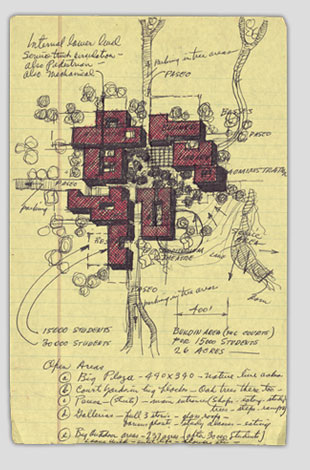
On the Background
An early concept of the UTSA campus by architect O’Neil Ford. From the Alexander Architectural Archive, The University of Texas Libraries, The University of Texas at Austin. Special thanks to the Ford family for granting permission for publication.

